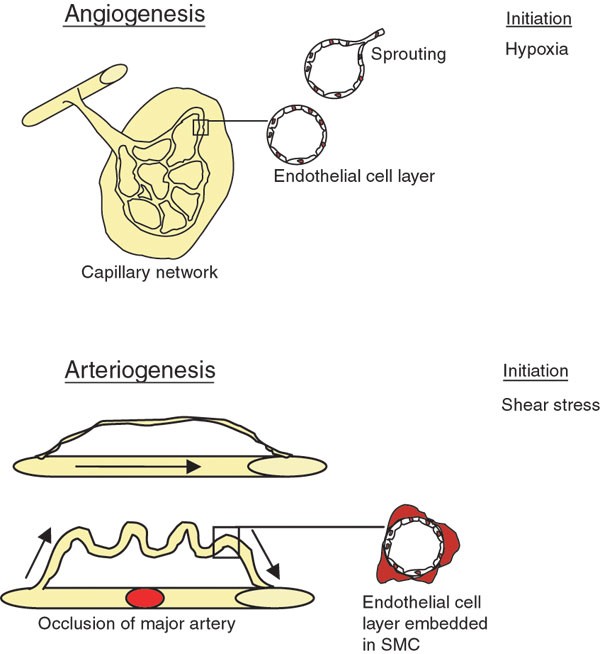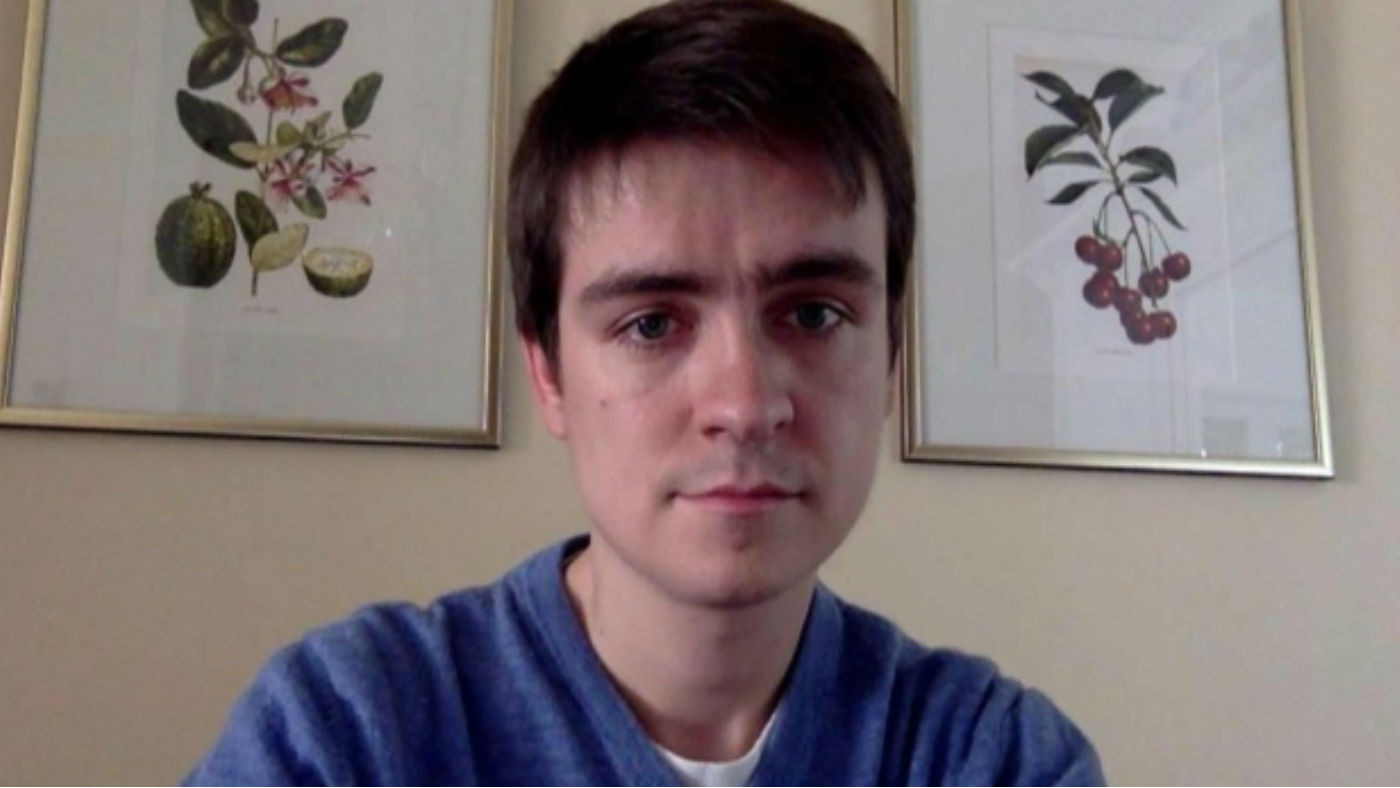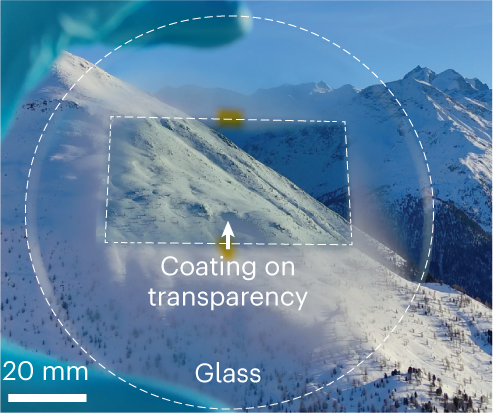
- Select a language for the TTS:
- UK English Female
- UK English Male
- US English Female
- US English Male
- Australian Female
- Australian Male
- Language selected: (auto detect) - EN
Play all audios:
ABSTRACT Cardiovascular and cerebrovascular disease represent the two most common causes of mortality and morbidity in western countries, and the treatment for these is generally by the
mechanical restoration of blood flow in the affected tissues. Stimulation of collateral artery growth (arteriogenesis) provides a potential alternative option for the treatment of patients
suffering from occlusive artery disease. Therefore, researchers have established several angiogenesis and arteriogenesis animal models to investigate basic mechanisms and pharmacological
modulation of collateral artery growth. The authors highlight the most important aspects of vascular growth, discuss different methods and techniques for examining the process, and review
the advantages and disadvantages associated with the animal models available for studying this phenomenon. Access through your institution Buy or subscribe This is a preview of subscription
content, access via your institution ACCESS OPTIONS Access through your institution ADDITIONAL ACCESS OPTIONS: * Log in * Learn about institutional subscriptions * Read our FAQs * Contact
customer support SIMILAR CONTENT BEING VIEWED BY OTHERS CORONARY VESSEL FORMATION IN DEVELOPMENT AND DISEASE: MECHANISMS AND INSIGHTS FOR THERAPY Article 25 June 2020 MODELING EARLY STAGE
ATHEROSCLEROSIS IN A PRIMARY HUMAN VASCULAR MICROPHYSIOLOGICAL SYSTEM Article Open access 27 October 2020 EXPERIMENTAL MURINE ARTERIOVENOUS FISTULA MODEL TO STUDY RESTENOSIS AFTER
TRANSLUMINAL ANGIOPLASTY Article 20 October 2020 REFERENCES * Risau, W. Mechanisms of angiogenesis. _Nature_ 386(6626), 671–674 (1997). Article Google Scholar * Risau, W. & Flamme, I.
Vasculogenesis. _Annu. Rev. Cell Dev. Biol._ 11, 73–91 (1995). Article CAS Google Scholar * Flamme, I., Frolich, T. & Risau, W. Molecular mechanisms of vasculogenesis and embryonic
angiogenesis. _J. Cell. Physiol._ 173(2), 206–210 (1997). Article Google Scholar * Asahara, T. et al. Isolation of putative progenitor endothelial cells for angiogenesis. _Science_
275(5302), 964–967 (1997). Article CAS Google Scholar * Urbich, C. & Dimmeler, S. Endothelial progenitor cells: characterization and role in vascular biology. _Circ. Res._ 95(4),
343–353 (2004). Article Google Scholar * Carmeliet, P. Mechanisms of angiogenesis and arteriogenesis. _Nat. Med._ 6(4), 389–395 (2000). Article Google Scholar * Folkman, J. Tumor
angiogenesis: therapeutic implications. _N. Engl. J. Med._ 285(21), 1182–1186 (1971). Google Scholar * Folkman, J. Anti-angiogenesis: new concept for therapy of solid tumors. _Ann. Surg._
175(3), 409–416 (1972). Article Google Scholar * Folkman, J. Tumor angiogenesis: a possible control point in tumor growth. _Ann. Intern. Med._ 82(1), 96–100. (1975). Article Google
Scholar * Carmeliet, P. et al. Role of HIF-1alpha in hypoxia-mediated apoptosis, cell proliferation and tumour angiogenesis. _Nature_ 394(6692), 485–490 (1998). Article Google Scholar *
Henry, T. et al. Double blind, placebo controlled trial of recombinant human vascular endothelial growth factor: the VIVA trial. _J. Am. Coll. Cardiol._ 33(2: Supp A), 384 (1999). Google
Scholar * Lower, R. _Tractus de Corde_ (Elsevier, Amsterdam, 1669). Google Scholar * Longland, C.J. The collateral circulation of the limb. _Ann. Roy. Coll. Surg. Engl._ 13(3), 161–164
(1953). Google Scholar * Ito, W.D. et al. Angiogenesis but not collateral growth is associated with ischemia after femoral artery occlusion. _Am. J. Physiol._ 273 (3 Pt 2), H1255–H1265
(1997). CAS PubMed Google Scholar * Deindl, E. et al. Role of ischemia and of hypoxia-inducible genes in arteriogenesis after femoral artery occlusion in the rabbit. _Circ. Res._ 89(9),
779–786 (2001). Article Google Scholar * Hoefer, I.E. et al. Arteriogenesis proceeds via ICAM-1/Mac-1- mediated mechanisms. _Circ. Res._ 94(9), 1179–1185 (2004). Article Google Scholar *
Scholz, D. et al. Expression of adhesion molecules is specific and time-dependent in cytokine-stimulated endothelial cells in culture. _Cell Tissue Res._ 284(3), 415–423 (1996). Article
Google Scholar * Scholz, D. et al. Ultrastructure and molecular histology of rabbit hindlimb collateral artery growth (arteriogenesis). _Virchows Arch._ 436(3), 257–270 (2000). Article
Google Scholar * van Royen, N. et al. CD44 regulates arteriogenesis in mice and is differentially expressed in patients with poor and good collateralization. _Circulation_ 109(13),
1647–1652 (2004). Article Google Scholar * Arras, M. et al. Monocyte activation in angiogenesis and collateral growth in the rabbit hindlimb. _J. Clin. Invest._ 101(1), 40–50 (1998).
Article Google Scholar * Ley, K., Allietta, M., Bullard, D.C. & Morgan, S. Importance of E-selectin for firm leukocyte adhesion in vivo. _Circ. Res._ 83(3), 287–294 (1998). Article
Google Scholar * Kukreti, S., Konstantopoulos, K., Smith, C.W. & McIntire, L.V. Molecular mechanisms of monocyte adhesion to interleukin-1β-stimulated endothelial cells under
physiologic flow conditions. _Blood_ 89(11), 4104–4111 (1997). Google Scholar * Languino, L.R. et al. Regulation of leukocyte-endothelium interaction and leukocyte transendothelial
migration by intercellular adhesion molecule 1-fibrinogen recognition. _Proc. Natl. Acad. Sci. USA_ 92(5), 1505–1509 (1995). Article Google Scholar * Morigi, M. et al. Fluid shear stress
modulates surface expression of adhesion molecules by endothelial cells. _Blood_ 85(7), 1696–1703 (1995). Google Scholar * Cai, W. et al. Altered balance between extracellular proteolysis
and antiproteolysis is associated with adaptive coronary arteriogenesis. _J. Mol. Cell. Cardiol._ 32(6), 997–1011 (2000). Article Google Scholar * Cai, W.J. et al. Remodeling of the
adventitia during coronary arteriogenesis. _Am. J. Physiol. Heart Circ. Physiol._ 284(1), H31–H40 (2003). Article Google Scholar * Scholz, D. et al. Early events in adaptive
arteriogenesis. _(Abstr.) J. Mol. Cell. Cardiol._ 30(Suppl), A127 (1998). Google Scholar * Hoefer, I., van Royen, N., Buschmann, I., Piek, J. & Schaper, W. Time course of arteriogenesis
following femoral artery occlusion in the rabbit. _Cardiovasc. Res._ 49(3), 609–617 (2001). Article Google Scholar * Pipp, F. et al. Elevated fluid shear stress enhances postocclusive
collateral artery growth and gene expression in the pig hind limb. _Arterioscler. Thromb. Vasc. Biol._ 24(9), 1664–1668 (2004). Article Google Scholar * Unger, E.F. Experimental evaluation
of coronary collateral development. _Cardiovasc. Res._ 49(3), 497–506 (2001). Article Google Scholar * Rentrop, K.P., Feit, F., Sherman, W. & Thornton, J.C. Serial angiographic
assessment of coronary artery obstruction and collateral flow in acute myocardial infarction. Report from the second Mount Sinai-New York University Reperfusion Trial. _Circulation_ 80(5),
1166–1175 (1989). Article Google Scholar * Fuchs, S., Shou, M., Baffour, R., Epstein, S.E. & Kornowski, R. Lack of correlation between angiographic grading of collateral and myocardial
perfusion and function: implications for the assessment of angiogenic response. _Coron. Artery Dis._ 12(3), 173–178 (2001). Article Google Scholar * Heil, M. et al. Blood monocyte
concentration is critical for the enhancement of collateral artery growth. _Am. J. Physiol. Heart Circ. Physiol._ 28(6), H2411–H2419 (2002). Article Google Scholar * Rivard, A. et al.
Age-dependent impairment of angiogenesis. _Circulation_ 99(1), 111–120 (1999). Article Google Scholar * Silvestre, J.S. et al. Antiangiogenic effect of angiotensin II type 2 receptor in
ischemia-induced angiogenesis in mice hindlimb. _Circ. Res._ 90(10), 1072–1079 (2002). Article Google Scholar * Schirmer, S.H. et al. Differential effects of MCP-1 and leptin on collateral
flow and arteriogenesis. _Cardiovasc. Res._ 64(2), 356–364 (2004). Article Google Scholar * Wright, C.E., Angus, J.A. & Korner, P.I. Vascular amplifier properties in renovascular
hypertension in conscious rabbits. _Hypertension_ 9(2), 122–131 (1987). Article Google Scholar * Buschmann, I.R. et al. Invasive and non-invasive evaluation of spontaneous arteriogenesis
in a novel porcine model for peripheral arterial obstructive disease. _Atherosclerosis_ 167(1), 33–43 (2003). Article Google Scholar * Voskuil, M. et al. Modulation of collateral artery
growth in a porcine hindlimb ligation model using MCP-1. _Am. J. Physiol. Heart Circ. Physiol._ 284(4), H1422–H1428 (2003). Article Google Scholar * Chien, G.L., Anselone, C.G., Davis,
R.F. & Van Winkle, D.M. Fluorescent vs. radioactive microsphere measurement of regional myocardial blood flow. _Cardiovasc. Res._ 30(3), 405–412 (1995). Article Google Scholar * Van
Oosterhout, M.F., Prinzen, F.W., Sakurada, S., Glenny, R.W. & Hales, J.R.S. Fluorescent microspheres are superior to radioactive microspheres in chronic blood flow measurements. _Am. J.
Physiol._ 275 (1 Pt 2), H110–H115 (1998). CAS PubMed Google Scholar * Buckberg, G. Studies of regional coronary flow using radioactive microspheres. _Ann. Thorac. Surg._ 20(1), 46–51
(1975). Article Google Scholar * Bassingthwaighte, J.B. et al. Validity of microsphere depositions for regional myocardial flows. _Am. J. Physiol._ 253 (1 Pt 2), H184–H193 (1987). CAS
PubMed PubMed Central Google Scholar * Glenny, R.W. Manual for Using Fluorescent Microspheres to Measure Regional Organ Perfusion (Fluorescent Microsphere Resource Center, Seattle, WA,
1996). * Yang, H.T., Ogilvie, R.W. & Terjung, R.L. Heparin increases exercise-induced collateral blood flow in rats with femoral artery ligation. _Circ. Res._ 76(3), 448–456 (1995).
Article Google Scholar * Yang, H.T., Laughlin, M.H. & Terjung, R.L. Prior exercise training increases collateral-dependent blood flow in rats after acute femoral artery occlusion. _Am.
J. Physiol. Heart Circ. Physiol._ 279(4), H1890–H1897 (2000). Article Google Scholar * Prior, B.M., Lloyd, P.G., Yang, H.T. & Terjung, R.L. Exercise-induced vascular remodeling.
_Exerc. Sport Sci. Rev._ 31(1), 26–33 (2003). Article Google Scholar * Scholz, D. et al. Contribution of arteriogenesis and angiogenesis to postocclusive hindlimb perfusion in mice. _J.
Mol. Cell. Cardiol._ 34(7), 775–787 (2002). Article Google Scholar * Heil, M. et al. Collateral artery growth (arteriogenesis) after experimental arterial occlusion is impaired in mice
lacking CC-chemokine receptor-2. _Circ. Res._ 94(5), 671–677 (2004). Article Google Scholar * Horvath, K.A. et al. Myocardial functional recovery after fibroblast growth factor 2 gene
therapy as assessed by echocardiography and magnetic resonance imaging. _Ann. Thorac. Surg._ 74(2), 481–486; discussion 487 (2002). Article Google Scholar * Wagner, S., Helisch, A.,
Bachmann, G. & Schaper, W. Time-of-flight quantitative measurements of blood flow in mouse hindlimbs. _J. Magn. Reson. Imaging_ 19(4), 468–474 (2004). Article Google Scholar * Wagner,
S., Helisch, A., Ziegelhoeffer, T., Bachmann, G. & Schaper, W. Magnetic resonance angiography of collateral vessels in a murine femoral artery ligation model. _NMR Biomed._ 17(1), 21–27
(2004). Article Google Scholar * Pipp, F. et al. VEGFR-1-selective VEGF homologue PlGF is arteriogenic: evidence for a monocyte-mediated mechanism. _Circ. Res._ 92(4), 378–385 (2003).
Article Google Scholar * van Royen, N. et al. Local monocyte chemoattractant protein-1 therapy increases collateral artery formation in apolipoprotein E-deficient mice but induces systemic
monocytic CD11b expression, neointimal formation, and plaque progression. _Circ. Res._ 92(2), 218–225 (2003). Article Google Scholar * Scholz, D. et al. Bone marrow transplantation
abolishes inhibition of arteriogenesis in placenta growth factor (PlGF)−/− mice. _J. Mol. Cell. Cardiol._ 35(2), 177–184 (2003). Article Google Scholar * Ito, W.D. et al. Monocyte
chemotactic protein-1 increases collateral and peripheral conductance after femoral artery occlusion. _Circ. Res._ 80(6), 829–837 (1997). Article Google Scholar * van Royen, N. et al.
Exogenous application of transforming growth factor-β1 stimulates arteriogenesis in the peripheral circulation. _FASEB J._ 16(3), 432–434 (2002). Article Google Scholar * Grundmann, S. et
al. Anti-tumor necrosis factor-α therapies attenuate adaptive arteriogenesis in the rabbit. _Am. J. Physiol. Heart Circ. Physiol._ 289(4), H1497–H1505 (2005). Article Google Scholar *
Kopelman, D., Hirshhorn, G. & Hashmonai, M. Prevention of limb loss in critical ischaemia by arterialization of the superficial venous system: an experimental study in dogs. _Cardiovasc.
Surg._ 6(4), 384–388 (1998). Article Google Scholar * Rakue, H. et al. Low-dose basic fibroblast growth factor and vascular endothelial growth factor for angiogenesis in canine acute
hindlimb insufficiency. _Jpn. Circ. J._ 62(12), 933–939 (1998). Article Google Scholar * Herzog, S., Sager, H., Khmelevski, E., Deylig, A. & Ito, W.D. Collateral arteries grow from
preexisting anastomoses in the rat hindlimb. _Am. J. Physiol. Heart Circ. Physiol._ 283(5), H2012–H2020 (2002). Article Google Scholar * Yang, H.T., Deschenes, M.R., Ogilvie, R.W. &
Terjung, R.L. Basic fibroblast growth factor increases collateral blood flow in rats with femoral arterial ligation. _Circ. Res._ 79(1), 62–69 (1996). Article Google Scholar * Kondo, T.
& Watanabe, Y. A heritable hyperlipemic rabbit [in Japanese]. _Jikken Dobutsu._ 24(3), 89–94 (1975). Google Scholar * Zhang, S.H., Reddick, R.L., Piedrahita, J.A. & Maeda, N.
Spontaneous hypercholesterolemia and arterial lesions in mice lacking apolipoprotein E. _Science_ 258(5081), 468–471 (1992). Article Google Scholar * Plump, A.S. et al. Severe
hypercholesterolemia and atherosclerosis in apolipoprotein E-deficient mice created by homologous recombination in ES cells. _Cell_ 71(2), 343–353 (1992). Article Google Scholar * van
Royen, N. et al. Effects of local MCP-1 protein therapy on the development of the collateral circulation and atherosclerosis in Watanabe hyperlipidemic rabbits. _Cardiovasc. Res._ 57(1),
178–185 (2003). Article Google Scholar Download references AUTHOR INFORMATION AUTHORS AND AFFILIATIONS * Department of Experimental Cardiology, UMC, University of Utrecht, The Netherlands
Imo E. Hoefer MD, PhD * Department of Cardiology, AMC, University of Amsterdam, The Netherlands Niels van Royen MD, PhD * BioVisioN AG, Medical Research, Hannover, 30625, Germany Marco M.
Jost PhD Authors * Imo E. Hoefer MD, PhD View author publications You can also search for this author inPubMed Google Scholar * Niels van Royen MD, PhD View author publications You can also
search for this author inPubMed Google Scholar * Marco M. Jost PhD View author publications You can also search for this author inPubMed Google Scholar CORRESPONDING AUTHOR Correspondence to
Imo E. Hoefer MD, PhD. ETHICS DECLARATIONS COMPETING INTERESTS Hoefer and van Royen are shareholders of Perfusion Technologies GmbH, Freiburg, Germany. RIGHTS AND PERMISSIONS Reprints and
permissions ABOUT THIS ARTICLE CITE THIS ARTICLE Hoefer, I., van Royen, N. & Jost, M. Experimental models of arteriogenesis: differences and implications. _Lab Anim_ 35, 36–44 (2006).
https://doi.org/10.1038/laban0206-36 Download citation * Received: 23 December 2004 * Accepted: 22 August 2005 * Issue Date: February 2006 * DOI: https://doi.org/10.1038/laban0206-36 SHARE
THIS ARTICLE Anyone you share the following link with will be able to read this content: Get shareable link Sorry, a shareable link is not currently available for this article. Copy to
clipboard Provided by the Springer Nature SharedIt content-sharing initiative






